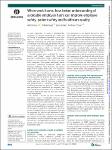When work harms: how better understanding of avoidable employee harm can improve employee safety, patient safety and healthcare quality
| dc.contributor.author | Jones, A | |
| dc.contributor.author | Neal, A | |
| dc.contributor.author | Bailey, S | |
| dc.contributor.author | Cooper, A | |
| dc.date.accessioned | 2023-11-23T12:34:24Z | |
| dc.date.available | 2023-11-23T12:34:24Z | |
| dc.date.issued | 2023-09-10 | |
| dc.identifier.issn | 2398-631X | |
| dc.identifier.issn | 2398-631X | |
| dc.identifier.uri | https://pearl.plymouth.ac.uk/handle/10026.1/21682 | |
| dc.description.abstract |
Healthcare settings are inherently dangerous environments, where employees globally are exposed to a myriad of overt risk hazards and stressors. Although employees globally have long been protected in law against physical or material hazards, such as radiation or the discharge of chemicals, psychosocial workplace risks and related avoidable harms are less tangible and poorly understood in healthcare literature. For example, a recent comprehensive review and analysis of national policies and approaches to occupational health across 12 countries concluded that workplace related psychosocial risks, mental health and well-being are overshadowed by the focus on physical workplace safety issues, due to lack of awareness and expertise on management of psychosocial risks and promotion of mental health.9 The following summary examples describe how suboptimal implementation of workforce policies can directly impact on the psychosocial health of employees. These exemplars also demonstrate the need to recalibrate the focus toward a more holistic and integrated approach to understanding employee well-being and harm. | |
| dc.format.extent | 59-62 | |
| dc.format.medium | Electronic | |
| dc.language | en | |
| dc.publisher | BMJ | |
| dc.subject | management | |
| dc.subject | communication | |
| dc.subject | learning organisation | |
| dc.title | When work harms: how better understanding of avoidable employee harm can improve employee safety, patient safety and healthcare quality | |
| dc.type | journal-article | |
| dc.type | Editorial Material | |
| plymouth.author-url | https://www.ncbi.nlm.nih.gov/pubmed/37696537 | |
| plymouth.issue | 1 | |
| plymouth.volume | 8 | |
| plymouth.publisher-url | http://dx.doi.org/10.1136/leader-2023-000849 | |
| plymouth.publication-status | Published | |
| plymouth.journal | BMJ Leader | |
| dc.identifier.doi | 10.1136/leader-2023-000849 | |
| plymouth.organisational-group | |Plymouth | |
| plymouth.organisational-group | |Plymouth|Faculty of Health | |
| plymouth.organisational-group | |Plymouth|Faculty of Health|School of Nursing and Midwifery | |
| plymouth.organisational-group | |Plymouth|REF 2021 Researchers by UoA | |
| plymouth.organisational-group | |Plymouth|Users by role | |
| plymouth.organisational-group | |Plymouth|Users by role|Academics | |
| plymouth.organisational-group | |Plymouth|REF 2021 Researchers by UoA|UoA03 Allied Health Professions, Dentistry, Nursing and Pharmacy | |
| plymouth.organisational-group | |Plymouth|REF 2028 Researchers by UoA | |
| plymouth.organisational-group | |Plymouth|REF 2028 Researchers by UoA|UoA03 Allied Health Professions, Dentistry, Nursing and Pharmacy | |
| dc.publisher.place | England | |
| dcterms.dateAccepted | 2023-08-11 | |
| dc.date.updated | 2023-11-23T12:34:23Z | |
| dc.rights.embargodate | 2023-11-24 | |
| dc.identifier.eissn | 2398-631X | |
| rioxxterms.versionofrecord | 10.1136/leader-2023-000849 |


